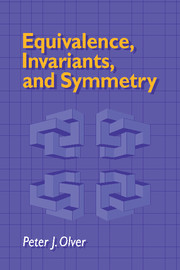Book contents
- Frontmatter
- Contents
- Preface
- Acknowledgments
- Introduction
- 1 Geometric Foundations
- 2 Lie Groups
- 3 Representation Theory
- 4 Jets and Contact Transformations
- 5 Differential Invariants
- 6 Symmetries of Differential Equations
- 7 Symmetries of Variational Problems
- 8 Equivalence of Coframes
- 9 Formulation of Equivalence Problems
- 10 Cartan's Equivalence Method
- 11 Involution
- 12 Prolongation of Equivalence Problems
- 13 Differential Systems
- 14 Frobenius' Theorem
- 15 The Cartan–Kähler Existence Theorem
- Tables
- References
- Symbol Index
- Author Index
- Subject Index
12 - Prolongation of Equivalence Problems
Published online by Cambridge University Press: 05 August 2012
- Frontmatter
- Contents
- Preface
- Acknowledgments
- Introduction
- 1 Geometric Foundations
- 2 Lie Groups
- 3 Representation Theory
- 4 Jets and Contact Transformations
- 5 Differential Invariants
- 6 Symmetries of Differential Equations
- 7 Symmetries of Variational Problems
- 8 Equivalence of Coframes
- 9 Formulation of Equivalence Problems
- 10 Cartan's Equivalence Method
- 11 Involution
- 12 Prolongation of Equivalence Problems
- 13 Differential Systems
- 14 Frobenius' Theorem
- 15 The Cartan–Kähler Existence Theorem
- Tables
- References
- Symbol Index
- Author Index
- Subject Index
Summary
Finally, we must tackle the problems in which the Cartan equivalence procedure does not lead to a complete reduction of the structure group, and, moreover, the structure equations are not involutive, so that (at least at the moment) we cannot deduce the existence of an infinite dimensional symmetry group. In practice, such problems, which include equivalence problems for differential equations and for Riemannian metrics, occur when the symmetry group has maximal dimension strictly larger than the dimension of the underlying manifold M upon which the original coframe was erected so as to encode the equivalence problem. (In principle, the structure equations could fail to be involutive even though an infinite-dimensional symmetry group is still present. However, I do not know any naturally occurring examples exhibiting this phenomenon, and, moreover, the prolongation procedure to be discussed below will handle this (remote) possibility as well.) In essence, then, the reason that the equivalence method has failed to produce the desired solution is because we have formulated the problem on a space whose dimension is too small to incorporate all possible symmetries of the problem.
Clearly, the resolution of the difficulty is to reformulate the problem on a suitably larger dimensional manifold and then, if necessary, reapply the Cartan reduction algorithm. The only difficulty, though, is how to construct the required higher dimensional equivalence problem. The prolongation method of Cartan resolves this problem, giving a natural, readily implementable method for appending new coordinates and new one-forms to our original coframe which continue to properly encode the problem at hand.
- Type
- Chapter
- Information
- Equivalence, Invariants and Symmetry , pp. 372 - 408Publisher: Cambridge University PressPrint publication year: 1995



